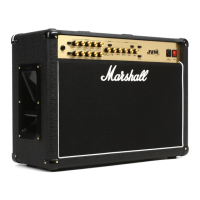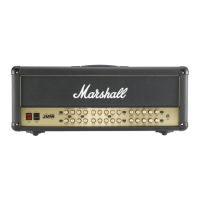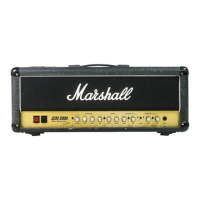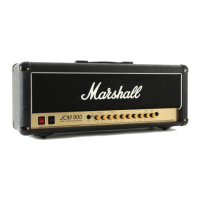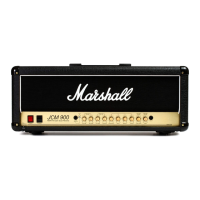ENGLISH
3.1
FRONT PANEL FUNCTIONS CONTINUED
The front panel is divided into 3 main sections:
channels, reverb and master. Each of the
channels has 3 modes which are differentiated
by the colour of the light in the button used to
change channel. These are green, orange or red
respectively.
1. POWER SWITCH
This turns the amp on and off.
2. STANDBY SWITCH
The standby switch is used in conjunction with
the power switch to warm up the amp before
use. Turn power switch on for 2 minutes before
switching standby on.
Set the standby switch to the off position
during breaks in performances.
Note: when the standby switch is off the amp
can be used without a load for silent recording.
See the ‘Using your amp for silent recording’
start-up procedure for more information.
3. FOOTSWITCH/MIDI PROGRAM SWITCH
This switch has a dual function:
1. Pressing it once will enter ‘footswitch
program’ mode. This is indicated by a solid
red light.
2. Pressing it twice will enter ‘MIDI program’
mode. This is indicated by a blinking red light.
See more information on these modes later in
this manual.
4. FX LOOP SWITCH
Engages/disengages the series/parallel FX loop
for the current channel.
Note: this switch does not affect the power
amp insert / series loop.
CHANNEL SECTION
Pressing a channel button has two functions:
• When pressing in the same channel it
cycles the gain modes: GREEN (lowest
gain level) > ORANGE > RED (highest gain
level)> GREEN etc. Each mode remembers
its own previous FX, reverb and master
settings.
• Coming from a different channel recalls
the last setting in the new selected
channel.
Note: when you leave and then reselect a
channel, it will automatically recall the last
active mode.
13. CLEAN/CRUNCH CHANNEL
Green mode: this is the cleanest of the three
modes. It uses a simple and straightforward
circuit keeping the signal as pure as possible. In
this mode the channel’s volume control is taken
out of circuit. This is the only JVM mode where
this happens.
Orange mode: this mode shares the preamp
topology of the classic Marshall JTM45/1959
‘Plexi’ models but with a bit more gain.
Red mode: with more gain than the orange
mode, this mode is reminiscent of the Marshall
JCM800 2203 amp, a staple of hard rock.
14. OVERDRIVE CHANNEL
Green mode: this is similar to the hot-rodded
JCM800 sound found in the red mode of the
clean/crunch channel. So, you can dial-in two
distinctly different yet similar crunch sounds if
you so wish - one in each channel.
Orange mode: this adds gain to the overdrive
green circuit, resulting in a sound that is perfect
for singing leads and hard rock tones.
Red mode: this mode has the highest amount
of gain, resulting in a fully distorted heavy metal
tone.
REVERB SECTION
The digital reverb is routed in parallel to the
main signal and mixed using a valve. The reverb
does not degrade the direct signal when
engaged and when off it is effectively removed
from the circuit.
10. REVERB SWITCH
Switches the reverb effect on or off for the
current channel.
Note: the reverb switching has been designed
to avoid abrupt cut offs when changing from
channel to channel or switching the reverb off,
so uses a tail that naturally decays.
11. REVERB CONTROL (OVERDRIVE CHANNEL)
Adjusts the level of reverb applied to the
overdrive channel.
12. REVERB CONTROL (CLEAN/CRUNCH
CHANNEL)
Adjusts the level of reverb applied to the clean/
crunch channel.
MASTER SECTION
The master volume controls set the overall
volume of the amp across all channels. Master 1
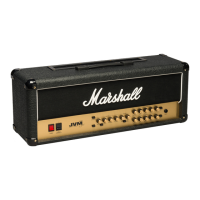
